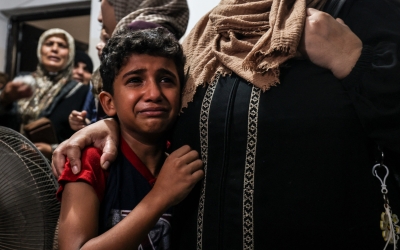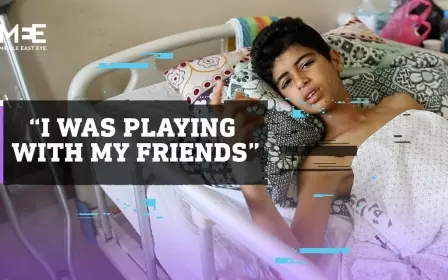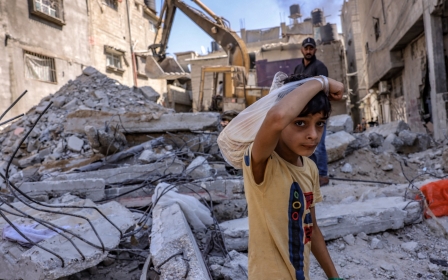Elections, Hamas and ceasefire: Why this will not be Israel's last war on Gaza

Israel’s latest aggression against the Gaza Strip caused the death of 45 Palestinian civilians, including 15 children, a total power cut and the destruction of dozens of homes and buildings.
The repeated scenario of using Gaza and its besieged population as cards on the Israeli election table is just scandalous in itself and in how the world keeps tolerating it
The attack was part of Israel's routine practice of "mowing the grass", a term that refers to reducing the military capabilities of the Palestinian resistance factions.
Translating this into a military operation, Israel began the aggression on 5 August by assassinating Tayseer al-Jabari, one of the leaders of the Palestinian Islamic Jihad (PIJ) movement, then declared that its objectives were to destroy the military bases and capabilities belonging to the movement.
Beyond these standard claims lies political opportunism and internal Israeli election considerations. Militarily and strategically, this round of aggression is part of an Israeli attempt to split the united front of the Palestinian resistance factions.
The war, ironically but also typically, was carried out without any serious international objection or criticism, camouflaged smartly by the so-called efforts of mediation led by Egypt to achieve a ceasefire.
New MEE newsletter: Jerusalem Dispatch
Sign up to get the latest insights and analysis on Israel-Palestine, alongside Turkey Unpacked and other MEE newsletters
Election manoeuvres
The repeated scenario of using Gaza and its besieged population as cards on the Israeli political and election table is just scandalous in itself and in how the world keeps tolerating it.
If a shaky Israeli government or a prime minister fears upcoming elections, the short-cut option to strengthen their position in the eyes of voters is to attack Gaza.
The pretext is a ready-made claim of protecting the security of the Israelis and hitting "terrorist organisations".
No matter how much Palestinian blood is shed, how many innocent people are killed and injured and the scale of destruction inflicted, the show goes on. In this last aggression, the world turned its back on Gaza, focusing instead on the Russia-Ukraine war.
The Iron Dome anti-missile system was very effective, and maybe this small-scale operation limited to PIJ was in part a training exercise on the updated technology added to the dome’s systems. The name of the attack, "Operation Breaking Dawn", reflected one thing the current Bennet-Lapid coalition government hoped to secure - a new "dawn" in power. Otherwise, there was no breaking of any dawn at the larger scale of things.
Within a wider strategy, Israeli generals have been attempting, since Operation Black Belt on Gaza in November 2019, to split the Palestinian resistance front. Israelis did target PIJ only, putting Hamas, the de facto ruler of Gaza, in an awkward position.
Hamas' standing
Viewed from its perspective, Hamas wants to spare the Palestinians in Gaza what it might perceive as an unnecessary confrontation. Israel was hoping that Hamas would exercise pressure on PIJ to not respond to the Israeli attacks and that PIJ would not listen and insist on engagement - and that this would create the targeted divide, and possible clashes.
What happened on the ground, however, did not match Israeli expectations.
Hamas gave the green light to PIJ to engage, and seems to have provided help and logistics, while remaining "officially" disengaged. The resistance groups in the Gaza Strip coordinate their work through what is known as the Common Operations Room.
Leaders of Hamas and PIJ have kept a common line statement that the room is commanding the resistance in this round of fighting as it did in previous ones.
Both groups expressed their full awareness of the Israeli objective to drive a wedge between them, and vowed to thwart it. Many observers in Gaza believe that the level of military coordination has in fact deepened during this round of fighting. The leader of PIJ, Ziyad Nakhla, highly praised Hamas in a press conference after declaring the ceasefire late on 7 August, saying that it represented "the backbone of resistance in the Gaza Strip".
To send a bold message against the Israeli strategy of divide and control, PIJ dubbed their defensive attack "Operation Unity of Fronts". This was designed to stress the connection between resistance in Gaza and the other forms of resistance in cities such as Jenin and Nablus in the West Bank, where PIJ has been actively in the lead over the last year.
The effort to unite resistance factions across Palestine reached a climax during last year's "Sword of Jerusalem" operation, when Hamas and PIJ joined ranks in the defence of Jerusalem. In the following year, the spirit of resistance across all of historic Palestine prevailed, including among the Palestinians inside the Green Line. This collective sentiment has got Israel extremely worried.
This latest war was part of the effort to break national connections of resistance, operationally and in the eyes of the Palestinians.
Egypt's mediation
The other common aspect of the Israeli attacks on Gaza relates to Egypt’s mediation efforts.
Many Palestinians expressed anger over what they perceived as a mechanism of deception, not mediation. For while Egypt was giving the impression that work was in progress to avoid escalation, Israel planned and carried out its assassination of the PIJ leader.
Sisi's Egypt cares less about the fate of two million Palestinians and more about projecting itself, and primarily to the US, as a regional player with significance
Prior to the killing, Israel arrested Bassam al-Saadi, another PIJ leader from the Jenin refugee camp. PIJ threatened that it would fire against Israeli towns adjacent to the Gaza Strip if Saadi was not released.
Egyptian mediation was manipulated and used by Israel, according to Palestinian critics, to prevent PIJ from taking the initiative, and for Israel to buy the time it needed to organise its strike.
As no official criticism came from Cairo in response to the Israeli deception, questions were raised over whether or not Egypt was informed by Israel about its planned strike.
Egypt looks like a crucial pacifier during and after each Israeli war on Gaza Strip. But in light of the little benefits that the Palestinians gain from Egypt’s diplomacy, Cairo’s real intentions seem to lie elsewhere.
Egypt refuses to supply the Gaza Strip with electricity, leaving it under Israel's mercy. The fuel that Gaza needs comes from Israel at a high price, whenever Israel wants and in calibrated quantities, that fit Israeli policies of pressure and squeeze.
Quiet suffocation
Previous ceasefire agreements brokered by Egypt were violated by Israel and deals on freeing prisoners, where Egypt was supposedly the guarantor, were also broken by Israel with no Egyptian response.
Lacking regional leverage and a role, the government of Abdel Fattah el-Sisi holds on to its so-called mediation as the only visible way of being involved in regional diplomacy, preventing other countries such as Jordan, Turkey or Qatar from intervening perhaps more effectively.
Sisi's Egypt cares less about the fate of the two million Palestinians, let alone their resistance, and more about projecting itself, and primarily to the US, as a regional player with significance.
The ending of this brutal assault against the Gaza Strip was very much welcome, especially as ordinary people suffer endlessly. Sadly, this will not be the last war on Gaza and the Palestinians. Mowing the grass is a grand Israeli strategy that applies to Palestinians everywhere.
In Gaza, however, succumbing to the Israeli equation of "calm for calm" implies the continuation of the occupation, misery, poverty and inhuman conditions for its people - calmly!
It means going back to the quiet suffocation of two million people, offered only two options: either to die screaming in war or die silently under siege.
The views expressed in this article belong to the authors and do not necessarily reflect the editorial policy of Middle East Eye.
Middle East Eye delivers independent and unrivalled coverage and analysis of the Middle East, North Africa and beyond. To learn more about republishing this content and the associated fees, please fill out this form. More about MEE can be found here.







